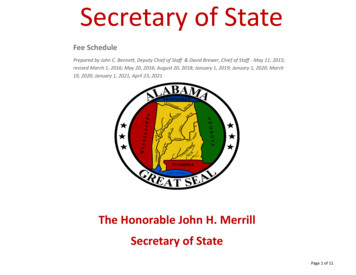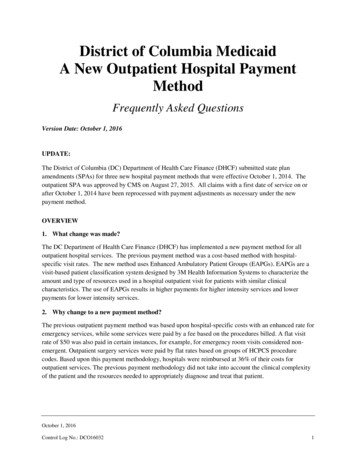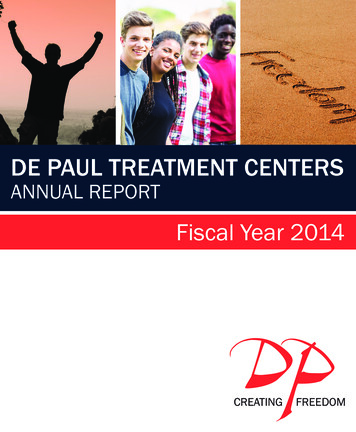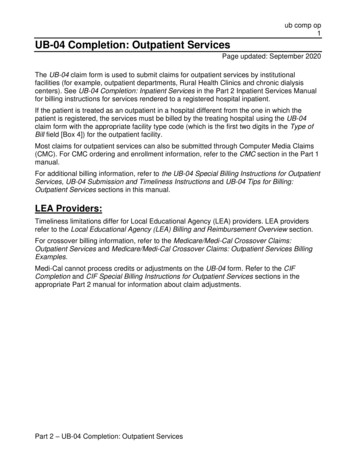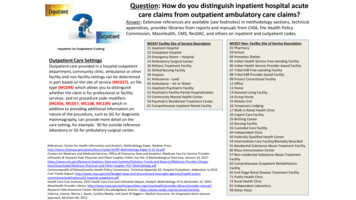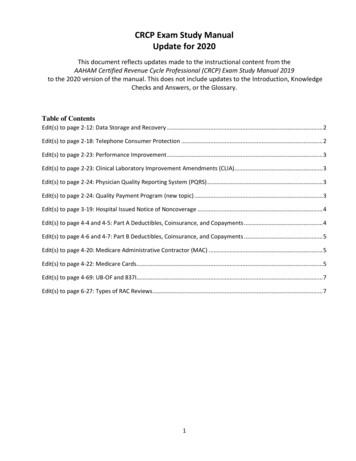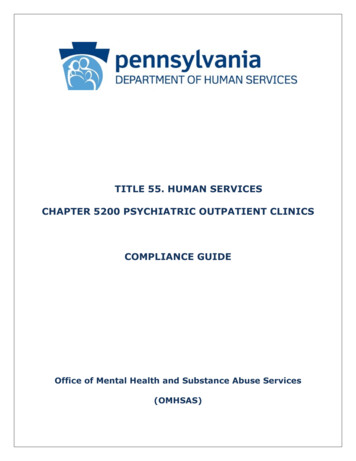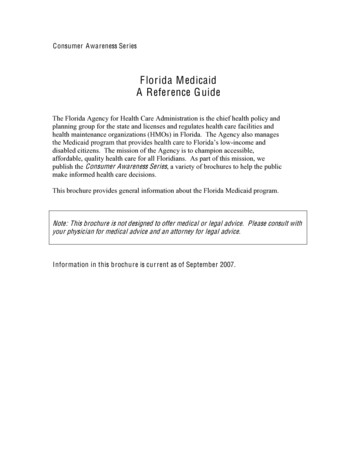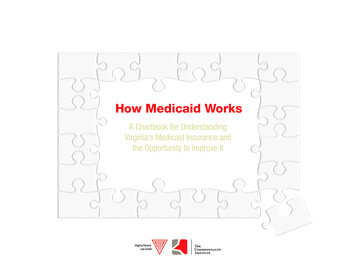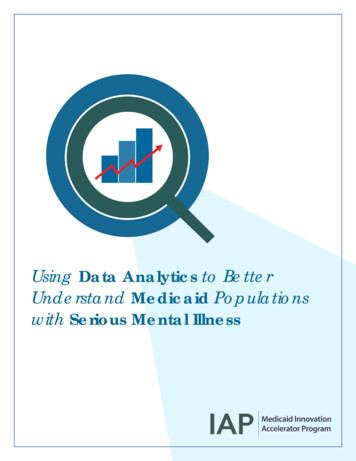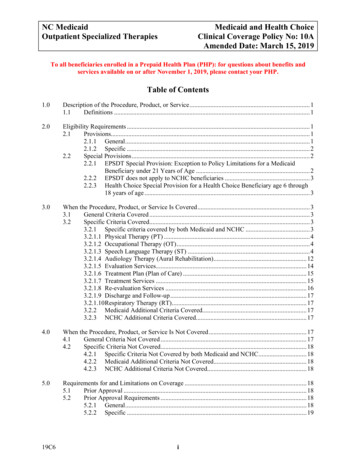
Transcription
NC MedicaidOutpatient Specialized TherapiesMedicaid and Health ChoiceClinical Coverage Policy No: 10AAmended Date: March 15, 2019To all beneficiaries enrolled in a Prepaid Health Plan (PHP): for questions about benefits andservices available on or after November 1, 2019, please contact your PHP.Table of Contents1.0Description of the Procedure, Product, or Service . 11.1Definitions . 12.0Eligibility Requirements . 12.1Provisions. 12.1.1 General . 12.1.2 Specific . 22.2Special Provisions . 22.2.1 EPSDT Special Provision: Exception to Policy Limitations for a MedicaidBeneficiary under 21 Years of Age . 22.2.2 EPSDT does not apply to NCHC beneficiaries . 32.2.3 Health Choice Special Provision for a Health Choice Beneficiary age 6 through18 years of age . 33.0When the Procedure, Product, or Service Is Covered . 33.1General Criteria Covered . 33.2Specific Criteria Covered. 33.2.1 Specific criteria covered by both Medicaid and NCHC . 33.2.1.1 Physical Therapy (PT) . 43.2.1.2 Occupational Therapy (OT) . 43.2.1.3 Speech Language Therapy (ST) . 43.2.1.4 Audiology Therapy (Aural Rehabilitation) . 123.2.1.5 Evaluation Services. 143.2.1.6 Treatment Plan (Plan of Care) . 153.2.1.7 Treatment Services . 153.2.1.8 Re-evaluation Services . 163.2.1.9 Discharge and Follow-up . 173.2.1.10Respiratory Therapy (RT) . 173.2.2 Medicaid Additional Criteria Covered. 173.2.3 NCHC Additional Criteria Covered. 174.0When the Procedure, Product, or Service Is Not Covered . 174.1General Criteria Not Covered . 174.2Specific Criteria Not Covered . 184.2.1 Specific Criteria Not Covered by both Medicaid and NCHC . 184.2.2 Medicaid Additional Criteria Not Covered. 184.2.3 NCHC Additional Criteria Not Covered. 185.0Requirements for and Limitations on Coverage . 185.1Prior Approval . 185.2Prior Approval Requirements . 185.2.1 General . 185.2.2 Specific . 1919C6i
NC MedicaidOutpatient Specialized Therapies5.35.45.5Medicaid and Health ChoiceClinical Coverage Policy No: 10AAmended Date: March 15, 2019Beneficiaries under the Age of 21 Years . 19Visit Limitations Beneficiaries 21 Years of Age and Older . 19Medical Necessity Visit Guidelines for Beneficiaries Under 21 Years of Age . 205.5.1 Physical and Occupational Therapy. 205.5.2 Speech-Language-Audiology Therapy . 205.5.3 Respiratory Therapy . 206.0Provider(s) Eligible to Bill for the Procedure, Product, or Service . 206.1Provider Qualifications and Occupational Licensing Entity Regulations. 216.2Provider Certifications . 227.0Additional Requirements . 227.1Compliance . 227.2Documenting Services . 227.3Post-Payment Reviews . 237.4Prepayment Claims Review . 237.5Requirements When the Type of Treatment Services Are the Same as Those Provided bythe Beneficiary’s Public School or Early Intervention Program. 238.0Policy Implementation and History . 24Attachment A: Claims-Related Information . 41A.Claim Type . 41B.International Classification of Diseases and Related Health Problems, Tenth Revisions,Clinical Modification (ICD-10-CM) and Procedural Coding System (PCS) . 41C.Code(s) . 42D.Modifiers. 42E.Billing Units. 42F.Place of Service . 43G.Co-payments . 43H.Reimbursement . 4319C6ii
NC MedicaidOutpatient Specialized TherapiesMedicaid and Health ChoiceClinical Coverage Policy No: 10AAmended Date: March 15, 2019Related Clinical Coverage PoliciesRefer to https://medicaid.ncdhhs.gov/ for the related coverage policies listed below:3A, Home Health Services5A-1, Physical Rehabilitation Equipment and Supplies5B, Orthotics & Prosthetics10B, Independent Practitioners10C, Local Education Agencies10D, Independent Practitioners Respiratory Therapy Services1.0Description of the Procedure, Product, or ServiceOutpatient Specialized Therapies consist of evaluations, re-evaluations, and multidisciplinaryevaluations as well as therapeutic physical, occupational, speech, respiratory, and audiologyservices provided in all settings except hospital and rehabilitation inpatient settings.1.1DefinitionsRefer to Subsection 6.1 Provider Qualifications and Occupational Licensing EntityRegulations2.0Eligibility Requirements2.1Provisions2.1.1General(The term “General” found throughout this policy applies to all Medicaid andNCHC policies)a. An eligible beneficiary shall be enrolled in either:1. the NC Medicaid Program (Medicaid is NC Medicaid program, unlesscontext clearly indicates otherwise); or2. the NC Health Choice (NCHC is NC Health Choice program, unlesscontext clearly indicates otherwise) Program on the date of service andshall meet the criteria in Section 3.0 of this policy.b. Provider(s) shall verify each Medicaid or NCHC beneficiary’s eligibilityeach time a service is rendered.c. The Medicaid beneficiary may have service restrictions due to theireligibility category that would make them ineligible for this service.d. Following is only ONE of the eligibility and other requirements forparticipation in the NCHC Program under GS 108A-70.21(a): Children mustbe between the ages of 6 through 18.CPT codes, descriptors, and other data only are copyright 2018 American Medical Association.All rights reserved. Applicable FARS/DFARS apply.19C61
NC MedicaidOutpatient Specialized Therapies2.1.2Medicaid and Health ChoiceClinical Coverage Policy No: 10AAmended Date: March 15, 2019Specific(The term “Specific” found throughout this policy only applies to this policy)MedicaidNone Apply.NCHCNone Apply.2.2Special Provisions2.2.1EPSDT Special Provision: Exception to Policy Limitations for aMedicaid Beneficiary under 21 Years of Agea. 42 U.S.C. § 1396d(r) [1905(r) of the Social Security Act]Early and Periodic Screening, Diagnostic, and Treatment (EPSDT) is afederal Medicaid requirement that requires the state Medicaid agency tocover services, products, or procedures for Medicaid beneficiary under 21years of age if the service is medically necessary health care to correct orameliorate a defect, physical or mental illness, or a condition [healthproblem] identified through a screening examination** (includes anyevaluation by a physician or other licensed clinician).This means EPSDT covers most of the medical or remedial care a childneeds to improve or maintain his or her health in the best condition possible,compensate for a health problem, prevent it from worsening, or prevent thedevelopment of additional health problems.Medically necessary services will be provided in the most economic mode,as long as the treatment made available is similarly efficacious to the servicerequested by the beneficiary’s physician, therapist, or other licensedpractitioner; the determination process does not delay the delivery of theneeded service; and the determination does not limit the beneficiary’s right toa free choice of providers.EPSDT does not require the state Medicaid agency to provide any service,product or procedure:1. that is unsafe, ineffective, or experimental or investigational.2. that is not medical in nature or not generally recognized as an acceptedmethod of medical practice or treatment.Service limitations on scope, amount, duration, frequency, location ofservice, and other specific criteria described in clinical coverage policies maybe exceeded or may not apply as long as the provider’s documentation showsthat the requested service is medically necessary “to correct or ameliorate adefect, physical or mental illness, or a condition” [health problem]; that is,provider documentation shows how the service, product, or procedure meetsall EPSDT criteria, including to correct or improve or maintain thebeneficiary’s health in the best condition possible, compensate for a healthproblem, prevent it from worsening, or prevent the development of additionalhealth problems.19C62
NC MedicaidOutpatient Specialized TherapiesMedicaid and Health ChoiceClinical Coverage Policy No: 10AAmended Date: March 15, 2019b. EPSDT and Prior Approval Requirements1. If the service, product, or procedure requires prior approval, the fact thatthe beneficiary is under 21 years of age does NOT eliminate therequirement for prior approval.2. IMPORTANT ADDITIONAL INFORMATION about EPSDT andprior approval is found in the NCTracks Provider Claims and BillingAssistance Guide, and on the EPSDT provider page. The Web addressesare specified below.NCTracks Provider Claims and Billing Assistance roviders/providermanuals.htmlEPSDT provider page: https://medicaid.ncdhhs.gov/2.2.2EPSDT does not apply to NCHC beneficiaries2.2.3Health Choice Special Provision for a Health Choice Beneficiary age 6through 18 years of ageNC Medicaid shall deny the claim for coverage for a NCHC beneficiary whodoes not meet the criteria within Section 3.0 of this policy. Only servicesincluded under the NCHC State Plan and the NC Medicaid clinical coveragepolicies, service definitions, or billing codes are covered for a NCHC beneficiary.3.0When the Procedure, Product, or Service Is CoveredNote: Refer to Subsection 2.2.1 regarding EPSDT Exception to Policy Limitations for aMedicaid Beneficiary under 21 Years of Age.3.1General Criteria CoveredMedicaid and NCHC shall cover procedures, products, and services related to this policywhen they are medically necessary, and:a. the procedure, product, or service is individualized, specific, and consistent withsymptoms or confirmed diagnosis of the illness or injury under treatment, and not inexcess of the beneficiary’s needs;b. the procedure, product, or service can be safely furnished, and no equally effectiveand more conservative or less costly treatment is available statewide; andc. the procedure, product, or service is furnished in a manner not primarily intended forthe convenience of the beneficiary, the beneficiary’s caretaker, or the provider.3.2Specific Criteria Covered3.2.1Specific criteria covered by both Medicaid and NCHCMedicaid and NCHC shall cover medically necessary Outpatient SpecializedTherapies when the service is ordered by a Medical Doctor (MD), Doctor ofOsteopathic Medicine (DO), Doctor of Podiatric Medicine (DPM), CertifiedNurse Midwife (CNM), Physician Assistant (PA), or Nurse Practitioner (NP)’sand when prior authorization is received. Home Health services may only beordered by an MD or DO.19C63
NC MedicaidOutpatient Specialized TherapiesMedicaid and Health ChoiceClinical Coverage Policy No: 10AAmended Date: March 15, 2019Note: Home Health: Physician referral, orders, plan of care, and documentationmust adhere to Medicare, Medicaid and NCHC requirements as outlined inclinical coverage policy 3A, Home Health Services. The service must complywith all other Home Health program requirements, including the appropriatenessof providing service in the home. The policy can be found athttps://medicaid.ncdhhs.gov/.3.2.1.1Physical Therapy (PT)Medicaid and NCHC shall cover medically necessary outpatientphysical therapy treatment when prior authorization is received. Referto Section 5.0.3.2.1.2 Occupational Therapy (OT)Medicaid and NCHC shall cover medically necessary occupationaltherapy treatment when prior authorization is received. Refer to Section5.0.3.2.1.3Speech Language Therapy (ST)Medicaid and NCHC shall cover medically necessary outpatientspeech-language therapy treatment when prior authorization isreceived. Refer to Section 5.0.a. Medically necessary treatment for oral phase, pharyngeal phase, ororopharyngeal phase dysphagia must contain documented findings.1. These findings must address ONE of the following deficitsconsistent with a dysphagia diagnosis:A. Coughing and choking while eating or drinking;B. Coughing, choking or drooling with swallowing;C. Wet-sounding voice;D. Changes in breathing when eating or drinking;E. Frequent respiratory infections;F. Known or suspected aspiration pneumonia;G. Masses on the tongue, pharynx or larynx;H. Muscle weakness, or myopathy, involving the pharynx;I. Neuromuscular degenerative disease likely to affectswallowing regardless of the presence of acommunication difficulty;J. Medical issues that affect feeding, swallowing, andnutrition; orK. Oral function impairment or deficit that interferes withfeeding.2. These findings must be indicated through ONE of thefollowing:A. Video fluoroscopic swallowing exam (VFSE), alsosometimes called a modified barium swallow exam(MBS);19C64
NC MedicaidOutpatient Specialized TherapiesMedicaid and Health ChoiceClinical Coverage Policy No: 10AAmended Date: March 15, 2019B.Fiber optic endoscopic evaluation of swallowing(FEES); or,C. Clinical feeding and swallowing evaluation.b. For a beneficiary who is a minority language speaker, there is acontinuum of proficiency in English.1. Determination of the minority language speaker’s proficiencyon the continuum must be documented as one of the following:A. Bilingual English proficient: a beneficiary who isbilingual and who is fluent in English or has greatercontrol of English than the minority language;B. Limited English proficient: a bilingual or monolingualbeneficiary who is proficient in his or her native language,but not English; orC. Limited in both English and the minority language: abeneficiary who is limited in both English and the minoritylanguage exhibits limited communication competence inboth languages.2. Evaluation must contain both objective and subjective measures todetermine if the beneficiary is more proficient in either the Englishlanguage or the minority language.3. For speech and language therapy services to be medically necessaryfor a beneficiary who is a minority language speaker, ALL thefollowing criteria must be met:A. All speech deficits must be present in the language in which thebeneficiary has the highest proficiency;B. All language deficits must be present in the language in whichthe beneficiary has the highest proficiency;C. The delivery of services must be in the language in which thebeneficiary has the highest receptive language proficiency; andD. If the use of interpreters or translators is the only alternative, thespeech-language pathologist or audiologist must:i. Provide sufficient instruction to the interpreter or translatorregarding the purposes, procedures and goals of the tests andtherapy methods;ii. For each date of service, the provider must ensure theinterpreter or translator understands his or her role as itrelates to the clinical procedures to be used and responsesexpected to address the goal;iii. Use the same interpreter or translator with a givenbeneficiary as consistently as possible; andiv. Use observation or other nonlinguistic measures assupplements to the translated measures, such as (1)beneficiary's interaction with parents, (2) beneficiary'sinteraction with peers, (3) pragmatic analysis.19C65
NC MedicaidOutpatient Specialized TherapiesMedicaid and Health ChoiceClinical Coverage Policy No: 10AAmended Date: March 15, 2019c. The following criteria applies to a Medicaid beneficiary under 21 years of ageand to a NCHC beneficiary between the ages of six through 18 yearsLanguage Impairment Classifications Infant/Toddler –A Medicaid Beneficiary Birth to 3 YearsMild Standard scores 1 to 1.5 standard deviations below the mean, orModerate Scores in the 7th –15th percentile, orA language quotient or standard score of 78 – 84, orA 20% - 24% delay on instruments that determine scores in months, orAdditional documentation indicating that the child exhibits functionalimpairment in one or more of the following language components:syntax, morphology, semantics or pragmatics. Standard scores 1.5 to 2 standard deviations below the mean, orScores in the 2nd – 6th percentile, orA language quotient or standard score of 70 – 77, orA 25% - 29% delay on instruments which determine scores in months,orAdditional documentation indicating that the child exhibits functionalimpairment in one or more of the following language components:syntax, morphology, semantics or pragmatics. Severe 19C6Standard scores more than 2 standard deviations below the mean, orScores below the 2nd percentile, orA language quotient or standard score of 69 or lower, orA 30% or more delay on instruments that determine scores in months,orAdditional documentation indicating that the child exhibits functionalimpairment in one or more of the following language components:syntax, morphology, semantics or pragmatics.6
NC MedicaidOutpatient Specialized TherapiesMedicaid and Health ChoiceClinical Coverage Policy No: 10AAmended Date: March 15, 2019Language Impairment ClassificationsA Medicaid Beneficiary –3 – 5 Years of AgeMild Moderate Severe 19C6Standard scores 1 to 1.5 standard deviations below the mean, orScores in the 7th – 15th percentile, orA language quotient or standard score of 78 – 84, orIf standard scores are not obtainable or are deemed unreliable,information gathered from checklists, observations, etc. thatdemonstrates a 6 to 12-month delay, orAdditional documentation indicating that the child exhibits functionalimpairment in one or more of the following language components:syntax, morphology, semantics or pragmatics.Standard scores 1.5 to 2 standard deviations below the mean, orScores in the 2nd – 6th percentile, orA language quotient or standard score of 70 – 77, orIf standard scores are not obtainable or are deemed unreliable,information gathered from checklists, observations, etc. thatdemonstrates a 13 to 18-month delay, orAdditional documentation indicating that the child exhibits functionalimpairment in one or more of the following language components:syntax, morphology, semantics or pragmatics.Standard scores more than 2 standard deviations below the mean, orScores below the 2nd percentile, orA language quotient or standard score of 69 or lower, orIf standard scores are not obtainable or are deemed unreliable,information gathered from checklists, observations, etc. thatdemonstrates a 19 month or more delay, orAdditional documentation indicating that the child exhibits functionalimpairment in one or more of the following language components:syntax, morphology, semantics or pragmatics.7
NC MedicaidOutpatient Specialized TherapiesMedicaid and Health ChoiceClinical Coverage Policy No: 10AAmended Date: March 15, 2019Language Impairment ClassificationsA Medicaid Beneficiary 5 through 20 Years of Age andA NCHC Beneficiary 6 through 18 Years of AgeMild Moderate Severe 19C6Standard scores 1 to 1.5 standard deviations below the mean, orScores in the 7th – 15th percentile, orA language quotient or standard score of 78 – 84 orIf standard scores are not obtainable or are deemed unreliable,information gathered from checklists, observations, etc. thatdemonstrate a 1 year to 1 year, 6-month delay, orAdditional documentation indicating that the child exhibits functionalimpairment in one or more of the following language components:syntax, morphology, semantics, or pragmatics.Standard scores 1.5 to 2 standard deviations below the mean, orScores in the 2nd – 6th percentile, orA language quotient or standard score of 70 – 77, orIf standard scores are not obtainable or are deemed unreliable,information gathered from checklists, observations, etc. thatdemonstrates a 1 year, 7-month to 2 year delay, orAdditional documentation indicating that the child exhibits functionalimpairment in one or more of the following language components:syntax, morphology, semantics or pragmatics.Standard scores more than 2 standard deviations below the mean, orScores below the 2nd percentile, orA language quotient or standard score of 69 or lower, orIf standard scores are not obtainable or are deemed unreliable,information gathered from checklists, observations, etc. thatdemonstrates a 2 year or more delay, orAdditional documentation indicating that the child exhibits functionalimpairment in one or more of the following language components:syntax, morphology, semantics or pragmatics.8
NC MedicaidOutpatient Specialized TherapiesMedicaid and Health ChoiceClinical Coverage Policy No: 10AAmended Date: March 15, 2019Articulation/Phonology Impairment ClassificationsA Medicaid Beneficiary birth through 20 Years of Age andA NCHC Beneficiaries 6 through 18 Years of AgeMild Standard scores 1 to1.5 standard deviations below the mean, orScores in the 7th – 15th percentile, orOne phonological process that is not developmentally appropriate, witha 20% occurrence, orAdditional documentation indicating a delay, such as percent consonantcorrect measures, measures of intelligibility, tests of stimulability, etc.Beneficiary is expected to have few articulation errors, generallycharacterized by typical substitutions, omissions, or distortions.Intelligibility not greatly affected but errors are noticeable.Moderate Standard scores 1.5 to 2 standard deviations below the mean, orScores in the 2nd – 6th percentile, orTwo or more phonological processes that are not developmentallyappropriate, with a 20% occurrence, orAt least one phonological process that is not developmentallyappropriate, with a 21% - 40% occurrence, orAdditional documentation indicating a delay, such as percent consonantcorrect measures, measures of intelligibility, tests of stimulability, etc.Beneficiary typically has 3 - 5 sounds in error, which are one year belowexpected development. Error patterns may be atypical. Intelligibility isaffected and conversational speech is occasionally unintelligible.Severe Standard scores more than 2 standard deviations below the mean, orScores below the 2nd percentile, orThree or more phonological processes that are not developmentallyappropriate, with a 20% occurrence, orAt least one phonological process that is not developmentallyappropriate, with more than 40% occurrence, orAdditional documentation indicating a delay, such as percent consonantcorrect measures, measures of intelligibility, tests of stimulability, etc.Beneficiary typically has more than five sounds in error with a combinationof error types. Inconsistent errors and lack of stimulability are evident.Conversational speech is generally unintelligible.19C69
NC MedicaidOutpatient Specialized TherapiesMedicaid and Health ChoiceClinical Coverage Policy No: 10AAmended Date: March 15, 2019Articulation Treatment Goals Based on Age of AcquisitionAge of AcquisitionTreatment Goal(s)Before Age 2Vowel soundsAfter Age 2, 0 months/m/, /n/, /h/, /w/, /p/, /b/After Age 3, 0 months/f/, /k/, /g/, /t/, /d/After Age 4, 0 months/n/, /j/After Age 5, 0 monthsvoiced th, sh, ch, /l/, /v/, jAfter Age 6, 0 months/s/, /r/, /z/, /s/ blends, /r/ blends, vowelized /r/,voiceless th, /l/ blendsIn using these guidelines for determining eligibility, total number of errors andintelligibility must be considered. A 90% criterion is roughly in accord with acceptededucational and psychometric practice that considers only the lowest 5% - 10% ofperformances on a standardized instrument to be outside the normal range.Phonology Treatment Goals Based on Age of Acquisition of Phonological RulesAge of AcquisitionTreatment Goal(s)After age 2 years, 0 monthsSyllable reduplicationAfter age 2 years, 6 monthsBacking, deletion of initial consonants, metathesis,labialization, assimilationAfter age 3 years, 0 monthsFinal consonant devoicing, fronting of palatals andvelars, final consonant deletion, weak syllabledeletion /syllable reduction, stridency deletion/stopping, prevocalic voicing, epenthesisWhen a beneficiary develops idiosyncratic patterns, which exist after age 3 years, 0months to 3 years, 5 months, they likely reflect a phonological disorder and must beaddressed in therapy.Minor processes or secondary patterns including glottal replacement, apicalization andpalatalization typically occur in conjunction with other major processes. These minorprocesses frequently correct on their own as those major processes are being targeted.After age 4 years, 0 monthsDeaffrication, vowelization and vocalization, clusterreductionAfter age 5 years, 0 monthsGliding19C610
NC MedicaidOutpatient Specialized TherapiesMedicaid and Health ChoiceClinical Coverage Policy No: 10AAmended Date: March 15, 2019Eligibility Guidelines for StutteringBorderline/Mild 3 – 10 sw/m or 3% - 10% stuttered words of words spoken, providedthat prolongations are less than 2 seconds and no struggle behaviorsand that the number of prolongations does not exceed total wholeword and part-word repetitions.ModerateMore than 10 sw/m or 10% stuttered words of words spoken, durationof dysfluencies up to 2 seconds; secondary characteristics may bepresent.SevereMore than 10 sw/m or 10% stuttered words of words spoken, durationof dysfluencies lasting 3 or more seconds, secondary characteristicsare conspicuous.Note: The service delivery may be raised to the higher level when: the percentage ofstuttered words and the duration fall in a lower severity rating, and th
3.2.1.3 Speech Language Therapy (ST) Medicaid and NCHC shall cover medically necessary outpatient speech-language therapy treatment when prior authorization is received. Refer to Section 5.0. a. Medically necessary treatment for oral phase, pharyngeal phase, or oropharyngeal phase dysphagia must contain documented findings. 1.
